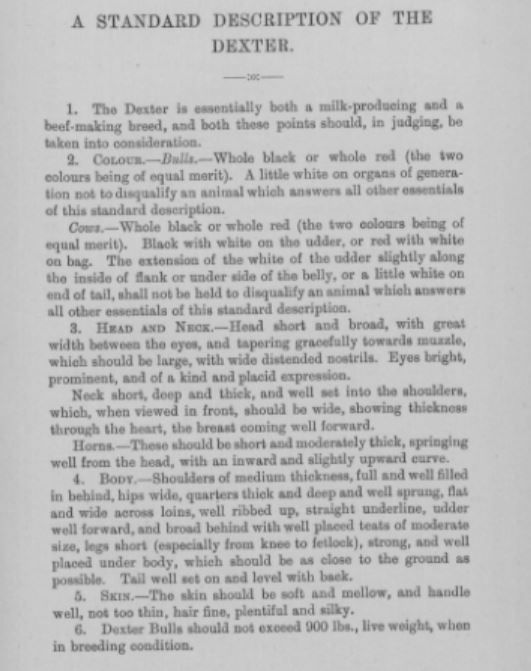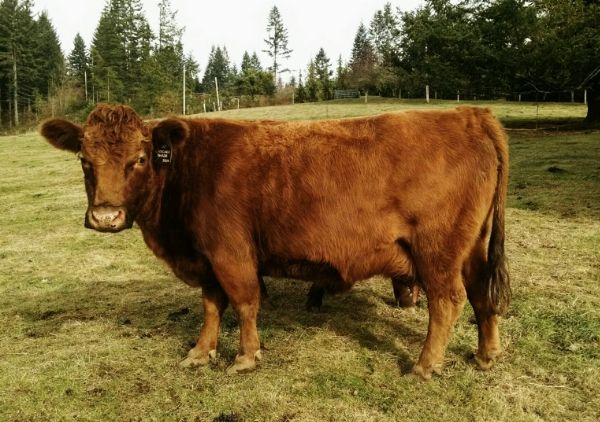|
|
Post by cascade on Jul 5, 2015 20:14:34 GMT
Short legged and long legged are descriptive terms for the dwarf Dexters that carry the chondro gene. I have a special fondness for the shorties and would have all shorties if it weren't for the threat of bulldog calves. If you breed two of the little dwarfs together you raise the possibility that you'll end up with a deformed calf that is born dead. That's why I kept a shortie bull and only long legged cows.
You can do it the other way, too. You can keep shortie cows as long as you use a long legged bull. Either way insures that you'll avoid having a bulldog calf.
One small note of clarification: Some old dexter breeders are still using old outdated confusing secret-code-word terminology to discuss the presence or absence of the Chondrodysplasia dwarfing gene. They say "short-legged" to mean Chrondrodysplasia-Dwarf.... but there are LOTS of dexters with short legs that are NON-Chondro. They say "long-legged" to mean NON-Chondro.... but there are LOTS of dexters with long legs that DO have the Chondro gene. Since 2002, we have well understood the lethal gene that causes Chondrodysplasia and we can easily perform a DNA test for it, using tail hairs. The ONLY way to eliminate the confusion of terminology is to stick to the terms "Chondro" vs. "Non-Chondro" to denote the presence or absence of the Chondrodysplasia dwarfing gene, and to only refer to leg length when you're actually discussing the length of the legs. If you prefer an entire herd of shorter dexters, you can get yourself some True-Short Dexters that don't have the chondro gene, and you can breed them freely without worrying about chondro deformities and death. |
|
|
|
Post by otf on Jul 5, 2015 20:46:38 GMT
Kirk, what precisely was unclear in genebo's post? Why do you feel it necessary to repeatedly comment in a negative fashion on certain people's posts? This is becoming very tiresome.
Gale
|
|
|
|
Post by cascade on Jul 5, 2015 21:39:06 GMT
Kirk, what precisely was unclear in genebo's post? Gale . He said: "Short legged and long legged are descriptive terms for the dwarf Dexters that carry the chondro gene." I hope you see something unclear in that. |
|
|
|
Post by otf on Jul 5, 2015 21:52:32 GMT
Okay, so he could insert "or don't carry" in that sentence.
I think what disturbs me the most is that no matter what anybody puts up on this board, you take an opportunity to push your own agenda. And that, my friend, is getting old.
Gale
|
|
|
|
Post by jamshundred on Jul 5, 2015 22:11:24 GMT
Deter cattle are a DWARF breed, choose your term. The characteristics treasured in this breed all flow from the dwarf cattle gathered for these unique and special qualities into a breed called Dexters. Forage conversion, early maturity, and docile, gentle personalities in the bulls and cows are without doubt connected to dwarf genetics,
at at some point in our history, Dexter owners and breeders lost touch with this historical fact, as well as early knowledge from breeders who knew the safest breeding was a dwarf to a non-dwarf to insure a hardy calf, maintain the valued breed traits yet keep the breed small as it was on the hillsides of Southern Ireland.
The loss of this knowledge and show competition among breeders in England evolved into herds with high death rates from homozygous dwarf aborts or calves. This is easily rectified when breeders are properly educated about the breed. There are still breeders who DO breed dwarf to dwarf and with education and experience the mortality rate in these breedings will be less than the quoted percentages for all breeds of cattle. A breeder in England has reported records at 6%. There IS a difference in the dwarf cattle which, for me, makes the risk one I am always willing to take.
Do NOT fear the dwarf cattle. They will bring you many hours of delight. And...learn about horns. You need not fear horns.
Bless the special little dwarf Dexter who has survived in spite of man and ignorance.
Judy
|
|
|
|
Post by cascade on Jul 5, 2015 23:40:55 GMT
Dictionary Says: Dwarf = " an animal or plant much below normal size" www.merriam-webster.com/dictionary/dwarfDexters are a breed much below normal sized cattle just like Nigerian Dwarf goats are a "dwarf" breed and American Guinea Hogs are a "dwarf" breed and Shetland ponies are a "dwarf" breed and Shetland Sheep are a "dwarf" breed (but none of them are based on Chondro). There are two ways to select for small cattle (and goats and pigs and sheep)... Method 1. Select those that are naturally shorter Method 2. Select those that are inflicted with a skeletal disease that makes them shorter. In the case of Dexters, before the Chondro-gene was found, and before a test was developed, it was difficult to select for naturally shorter cattle without accidentally including some with genetic diseases like chondrodysplasia that interfere with normal bone development. Nothing in this old breed description talks about long legs, or Chondro. The old breed description clearly says ALL Dexters should have shorter legs and you can't do that with Chondro.  |
|
|
|
Post by jamshundred on Jul 5, 2015 23:51:38 GMT
Kirk,
That at is NOT the original breed description which is published in the Iris herd book #1 as published by Professor Low in 1845 which clearly describes the Dwarf characteristics even to the hock. As a matter of fact it isn't even the second one. So if you want to debate with me then I like a fair and level playing ground which I define as being honest. you shoukd insist upon that from your mentor as well, or at the least check and verify all that is fed to you so you don't appear to be lacking in standards.
judy
|
|
|
|
Post by cascade on Jul 6, 2015 0:51:49 GMT
Kirk, That at is NOT the original breed description which is published in the Iris herd book #1 as published by Professor Low in 1845 which clearly describes the Dwarf characteristics even to the hock. As a matter of fact it isn't even the second one. So if you want to debate with me then I like a fair and level playing ground which I define as being honest. you shoukd insist upon that from your mentor as well, or at the least check and verify all that is fed to you so you don't appear to be lacking in standards. judy You are my mentor.... I got that old standard breed description from you (and appreciate it very much as I do appreciate ALL the data and info that you gather). Can you post the old, old original so I can pick it apart? It's always good to have a fresh pair of eyes look at that stuff to tell you what you might have missed. I can't imagine anyone who was starting a new breed not having a goal of trying to standardize the breed to a certain type. |
|
|
|
Post by jamshundred on Jul 6, 2015 4:36:28 GMT
LOL! I wish I had been your mentor. Your pastures would be filled with shiny black cattle with broad foreheads crowned with regal horns, and adoring eyes that would beg for treats. Oh, they would also be tiny dwarf carriers or proportionate non-carrier offspring.
The original and first breed description is on page 7 of the preface to herd book #i RDS. It is in the historical pages here and on the historical pages of FB.
i really, really, do wish there and been honesty in the breed and good breeders did not end up with cattle that never should be found in the American herd.
judy
|
|
|
|
Post by cascade on Jul 6, 2015 20:39:48 GMT
Here's what that old original description says about dexters: "A few honourable exceptions, however, exist to this general neglect of the mountain dairy breed of Ireland. One attempt had succeeded to such a degree as to form a new breed, which partially exists with the characters communicated to it. It has been termed the Dexter Breed. It was formed by the late Mr. Dexter, agent to Maude Lord Hawarden. This gentleman is said to have produced his curious breed by selection from the best mountain cattle of the district. He communicated to it a remarkable roundness of form and shortness of legs. The steps by which this improvement was effected, have not been sufficiently recorded; and some doubt may exist whether the original was the pure Kerry, or some other breed proper to the central parts of Ireland, or whether some foreign blood, as the dutch, was not mixed in with the native race."
"One character of the Dexter breed is frequently observed in certain cattle of Ireland, namely, short legs, and a small space from the knee and hock to the hoofs"
"However the breed has been formed, it still retains it's name, and the roundness and depth of carcase which distinguished it."Notice that it says NOTHING about horns, and says NOTHING about a long-legged dexter type. Instead, it says ALL dexters should have shorter legs and you can't do that with chondro. Here's a true-breeding, true-short (non-chondro) Dexter with a small space from the knee and hock to the hoofs and a round and deep body form. This animal meets the old original breed description perfectly and when bred on a similar animal, 100% of the offspring would also meet the old original breed description.  |
|





